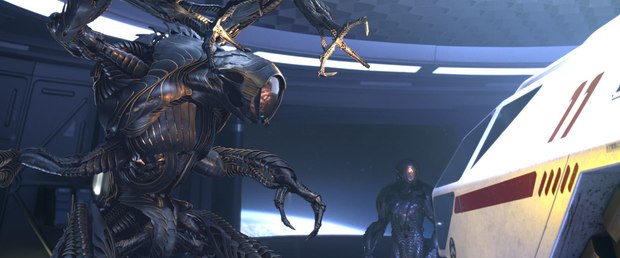Using assets from the award-winning Netflix series, NVIDIA teams with Autodesk and Vancouver VFX studio Image Engine to showcase real-time GPU-accelerated rendering workflows with RTX Server and Quadro vDWS.
Using real-world assets from Netflix’s award-winning show Lost in Space , NVIDIA this week is showcasing the flexibility and impressive rendering speed of NVIDIA RTX Server and Quadro Virtual Data Center Workstation (Quadro vDWS) at its GPU Technology Conference, which kicked off on Monday and runs through Friday, March 18 in San Jose, CA.
In collaboration with Autodesk and Vancouver-based VFX studio Image Engine, NVIDIA is demonstrating how artists and studios can produce more visually rich content faster than ever with powerful GPU-accelerated rendering on industry-standard NVIDIA RTX-enabled Autodesk Arnold renderer.
Well known for its Oscar-nominated work on Neill Blomkamp’s District 9, Image Engine has created ultra-realistic characters, environments and simulations for television and film, such as Game of Thrones, Jurassic World: Fallen Kingdom and Fantastic Beasts: The Crimes of Grindelwald.
At GTC 2019, NVIDIA is showing Image Engine’s attack robot from Lost in Space on an RTX Server virtual workstation running Autodesk Maya in real-time. Autodesk Arnold rendered the assets -- and reduced the time needed by six times per frame on GPU when compared to CPU. Performance scales to 25 times faster on a four-GPU render node over a typical CPU render node for entire shots or animations.
With NVIDIA RTX Server, artists can explore more creative options while creating higher quality effects that would ordinarily take too long to attempt. GPU-rendering also results in faster client review cycles with entire turntables or shots, rather than single frames or partial shots.
“We’re thrilled to collaborate with NVIDIA and Autodesk on the next generation of high-performance production rendering. Delivering the best creative results fast is critical to our success,” said Carsten Kolve, digital supervisor at Image Engine. “GPU rendering on NVIDIA RTX Server with Autodesk Arnold promises to deliver the exponential leap in speed we hope to utilize in all production departments.”
Streaming services like Netflix continuously raise the bar on visual quality, and design teams around the world increasingly collaborate and turn to new technology to create high-quality visual effects that meet audiences’ expectations. With RTX Server and Quadro vDWS, designers can accelerate the entire rendering pipeline, as well as virtualize content creation for increased collaboration in geographically dispersed productions.
Design teams are turning to virtual workstations to create photorealistic visual effects with accelerated rendering power. The Turing architecture provides advancements in ray-tracing, AI, advanced shading, and simulation -- all of which can be experienced from a virtual workstation on the RTX Server.
With Quadro vDWS, studios can have one, easy-to-manage server with multiple virtual workstations so designers can share GPU resources and securely access their work from any location.
“The ray-tracing compute capabilities of NVIDIA’s RTX GPUs and RTX Server, now with virtual workstations, are helping artists push the boundaries of content creation,” said Chris Vienneau, senior director of Media & Entertainment Products at Autodesk. “The Arnold GPU beta is now available to all our customers and we are excited to see how our users will take advantage of the unprecedented rendering speeds and amazing efficiency thanks to the powerful RT Cores, Tensor Cores and CUDA cores.”
Source: NVIDIA








